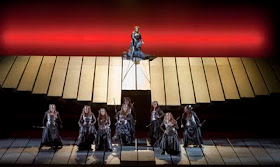We break down (poor choice of words) the Lepage Ring.
by Paul Pelkonen
So now that Götterdämmerung has been broadcast in the movie theaters, it's time to take a look at all four parts of the Metropolitan Opera's multimillion dollar production of Wagner's Ring.
by Paul Pelkonen
 |
| The new Ring cost millions. Hope rich Uncle Pennybags™ likes opera. Card from Monopoly™ © 1936 Parker Brothers Games. |
Canadian director Robert Lepage came to Wagner's operas with what seemed to be a deliberately naïve view: to use high technology and digital projections to recreate a fairly literal version of the Germanic myths that inspired the composer. The costumes were directly drawn from old productions of the Ring, right down to the little metal helmets worn by the Valkyries and Wotan's undersized partisan-shaped spear.
To be sure, this cycle developed over the year and a half it took to premiere, with Siegfried and Götterdämmerung showing advances in technology that solved some of the serious problems existent in the earlier opera. But the biggest problem with this cycle is Mr. Lepage's decision to minimize the acting surface of the Met stage, giving his singers almost nowhere to go except the narrow grey board-walk of planks that stood on the lip of the stage underneath the Machine, or a trench underneath that hid the singers' legs from the view of the audience and made it harder for them to sing.
 |
| The downward spiral: Stunt doubles make the Journey to Nibelheim in Scene III of Das Rheingold. Photo by Ken Howard © 2010 The Metropolitan Opera. |
Deborah Voigt has made a valiant effort at Brunnhilde. There's no question that she understands the character, the role and its pitfalls. She had a strong Walküre, a rough night in Siegfried and seemed to find focus in Götterdämmerung in the opera's second half. Jay Hunter Morris (a last-minute replacement) remains a Siegfried-lite, capable of embodying the role of Wagner's muscle-headed hero and singing with (mostly) pleasing tone. But his voice is small, and the singer skated over the most difficult moments in the score.
 |
| Deborah Voigt rides the Machine in Act III of Die Walküre. Photo by Ken Howard © 2011 The Metropolitan Opera. |
There are some other fine singers in the smaller roles. Wendy Bryn Harmer displayed flying Wagnerian colors as Gutrune (Götterdämmerung). Gerhard Siegel's Mime. Hans-Peter König's Fafner, Hunding and best of all, Hagen made a case for treating Wagner's villains as a mini-cycle--a feat also managed by basses Matti Salminen and Erik Halfvarson in the past. The mezzos of the operas: Stephanie Blythe as Fricka and Waltraud Meier as Waltraute were also compelling, making one wish both characters had more to do.
 |
| Jay Hunter Morris battles a balloon in Act II of Siegfried. Photo by Ken Howard © 2012 The Metropolitan Opera. |
The Machine has been the subject of much comment (and much satire) on this blog in the last year. The best thing that can be said for it is that when it does work (usually as a ginormous movie screen for those digital, screen-saver like projections) it looks pretty cool. (The worst thing is that those plank-ends do look like cannons, aimed squarely at the bloggers sitting in the Family Circle.) I will admit that there is a small thrill in seeing those planks MOVE like a living thing to Wagner's music, coming alive and seeming to dance (albeit clumsily) to the score like a huge Frankenstein puppet.
 |
| Act II of Götterdämmerung with Deborah Voigt downstage. Photo by Ken Howard © 2012 The Metropolitan Opera. |
Full reviews of each opera are available on Superconductor.
Das Rheingold: "Machine Messiah": Oct 5, 2010.
Die Walküre: "Machines (Back to Humans)": April 23, 2011.
Siegfried: "A Man, A Machine and a Big Snake": Oct. 28, 2011.
Götterdämmerung: "The Last Plank": Jan. 28, 2012.
